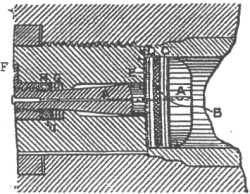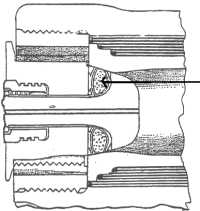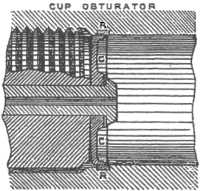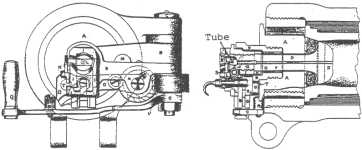The Gun - Rifled OrdnanceObturationAlthough the Director of Artillery (UK) favoured the French system of obturation, manufacture of new equipment promised to be a lengthy business, so in the meantime the British Government bought a number of BL 6-inch and 8-inch guns from the Elswick Ordnance Company (EOC). Although these guns were fitted with screw breech mechanisms, obturation was by Elswick cup. The cup system consisted of a shallow steel cup 'C' held against the face of the breech screw by a spindle and nut. While the back of the cup was flat, the face of the screw was slightly convex. When the gun fired the cup was expanded into contact with the copper ring 'R' thus sealing the breech and preventing the escape of propellant gas to the rear. Among the guns fitted with the Elswick cup were the BL 12-pr of 1881 and the BL 6-inch Mk 5 gun. The BL 9.45 howitzer also employed a similar system of obturation. In it the cup was much longer and acted rather like a cartridge case.
When the new system worked well, damaged cups could be easily replaced, but to replace the ring needed the services of a skilled artificer. Both cups and rings had to be kept scrupulously clean; the smallest particle of grit or dirt would start scoring. Furthermore, the cup had to be turned after each round to prevent it furrowing the ring. The system was allowed to die out eventually being replaced by the de Bange system. | |
|
The figure opposite shows an early breech screw with a 'slow cone' obturator adopted in 182 for all BL guns not already in service. The term 'slow cone' refers to the shape of the assembled mushroom head and pad which together formed the frustum of a cone with an angle from three to six degrees (3° in the figure). The pad 'B' was made of a mixture of asbestos and tallow or rape oil enclosed in a canvas cover shaped by hydraulic pressure. When the breech was closed the action of the screw pushed the mushroom head and the obturator into the chamber, the end of which formed a seating shaped to take it. On the gun being fired, pressure of the propellant gas acting on the mushroom head squeezed the pad against the breech screw causing it to expand radially, thus effectively sealing the breech.
|

Slow cone pad obturator on long or cylindrical screw. 'A' = Mushroom-headed steel spindle. 'B' = Obturator pad. 'C' and 'D' = Metal adjusting discs. 'E' = Steel adjusting discs. 'F' = Slide box. 'G' = Spring. 'H' = Nut. 'I' = Washer.
|
|
With the pressure removed after firing, the spindle and mushroom head returned to their original positions. The breech could then be easily opened by withdrawal of the screw. | |
|
The figure opposite shows an example of the steep-coned obturator fitted to the Welin single-motion mechanism shown on the previous page. The obturator cone angle is 26° as against the 3° of the example above. The combination of steep cone and short screw enabled the breech to be opened or closed with a single motion of the lever breech mechanism (LBM) instead of the four distinct operations detailed above. Heavy guns intended for Navy or coast defence were axially vented as depicted in the two figures below. Very early pieces, eg BL 6-in Mk 2, simply had a tube holder attached to the vent. Attached to the rear of the vent in later marks was a slide box carrying a 'lock' the two together forming a miniature breech mechanism designed to handle 'tubes vent sealing', introduced in 1882. Locks were designated 'electric' (E), 'percussion' (P), or 'E and PF' according to the types of tube fired.
|

Welin single-motion breech with steep-coned (26°) obturator. |
|
The tubes, which resembled small arm cartridges with no bullets, were filled with fast burning powder which when ignited sent a strong flash through the vent to ignite the propellant charge in the chamber. There were two types, one designed to be fired electrically, the other mechanically, ie by percussion. On the other hand, field and siege (medium) artillery Gunners inherited the 'T' friction tube as used in RML ordnance. Early field guns, eg BL 12-pr 6-cwt Mk 1, had no locks. Instead the end of the axial vent was shaped to make a 'T' friction tube.
The mark 1 guns were fitted with four-motion breech mechanisms as shown below. Later marks of these guns were fitted with single motion mechanisms and steep-coned obturators but the breeches were still designed to take the 'T' friction tube.
In the figure on the right above the gun has just fired. Lifting 'C' to the position shown on the left unlocks the breech and frees the empty tube which can be removed by hand. Opening of the breech is completed by turning 'C' part of a turn anti-clockwise to disengage the screw from the breech, and swinging the screw clear on the carrier 'G'.
WL Ruffell, 2002 previous | index | next | History index | Home | |




